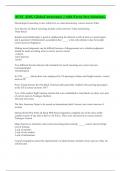Resume
Corporate Valuation for MSc Finance Summary
- Cours
- Établissement
- Book
In this document you'll find a summary of the first 18 chapters from the valuation book used in the course Corporate Valuation of the Master Finance. The summary is useful during the two cases as a guideline, and also to prepare for the exam.
[Montrer plus]














